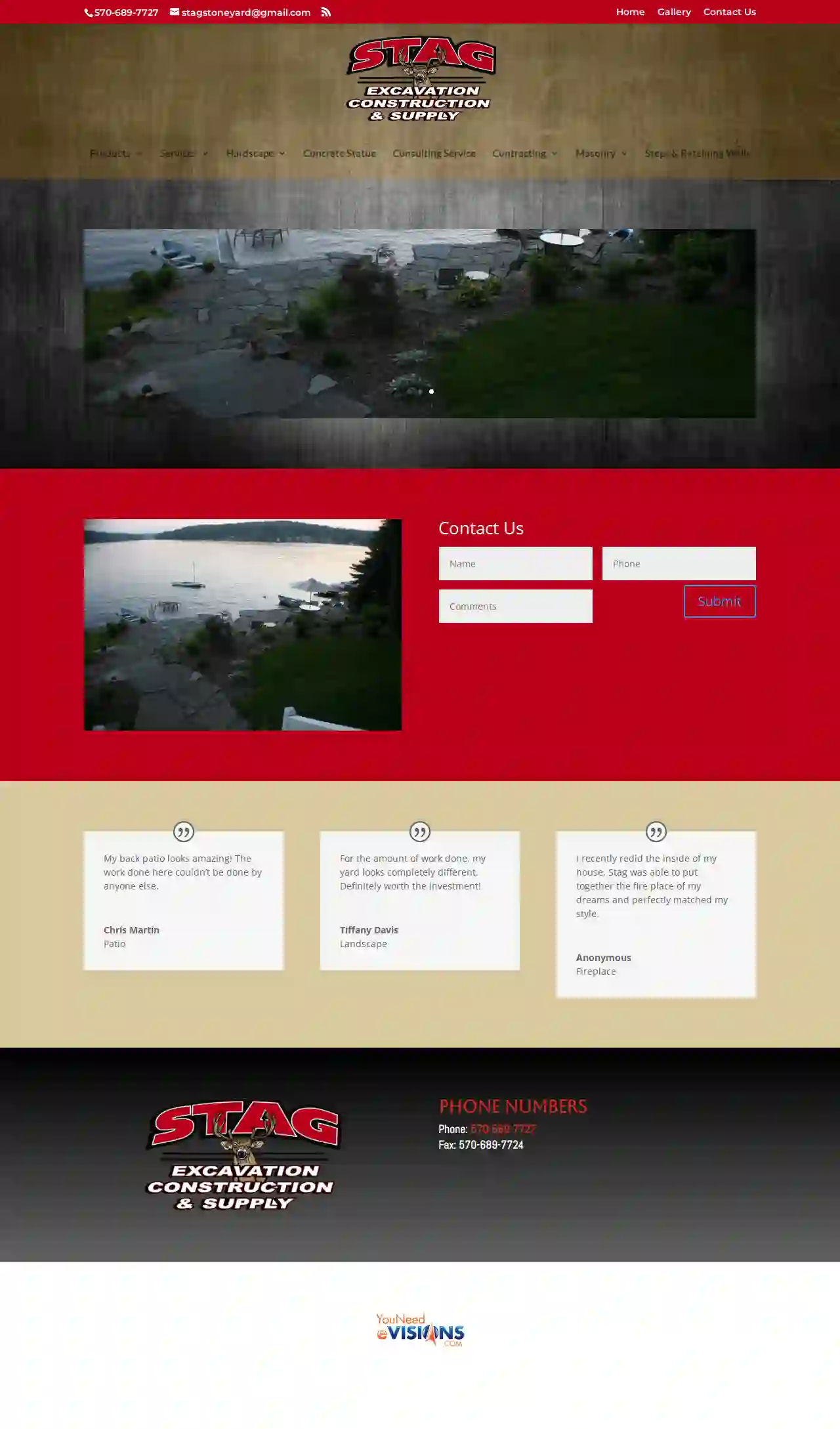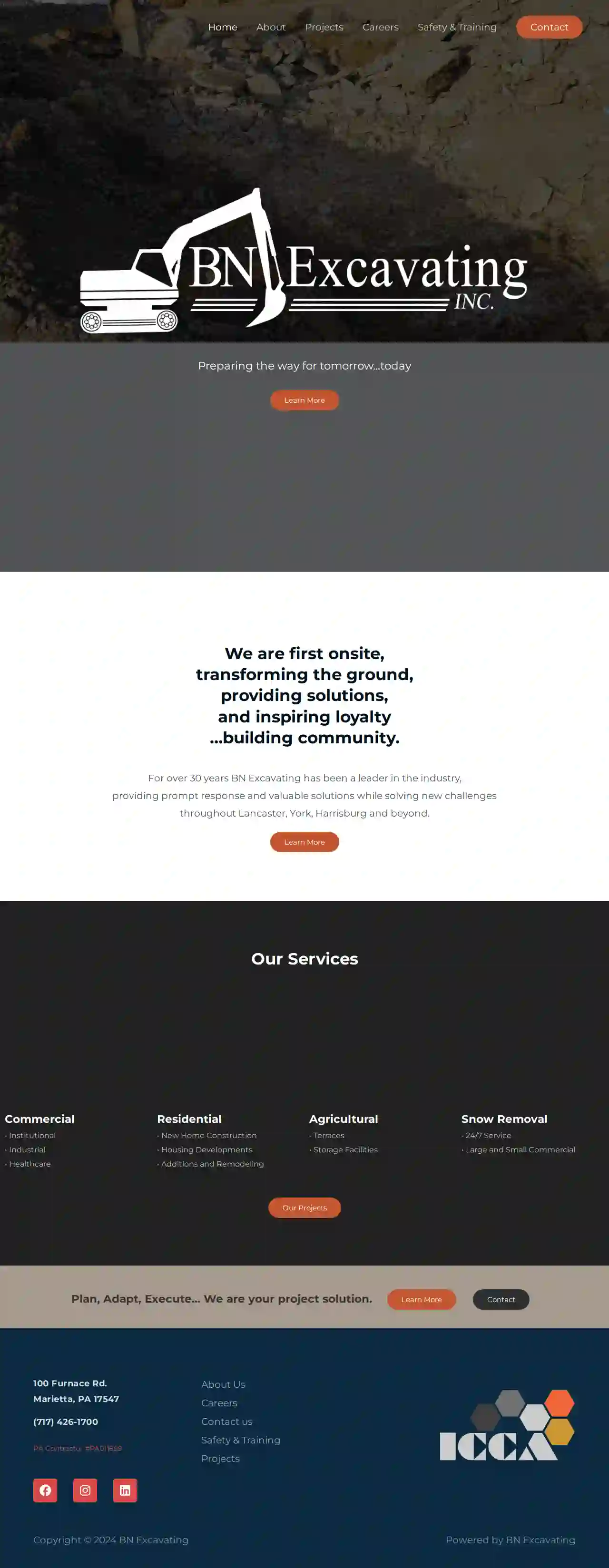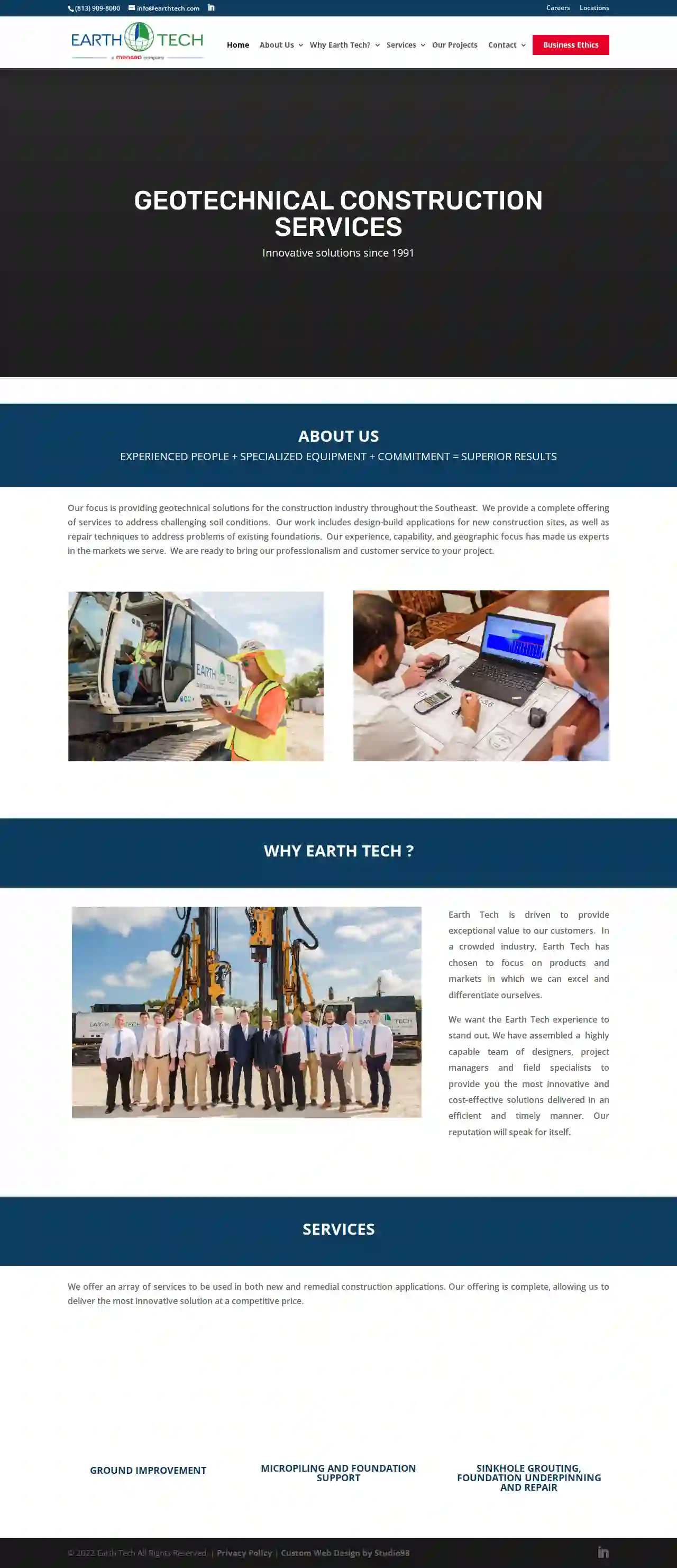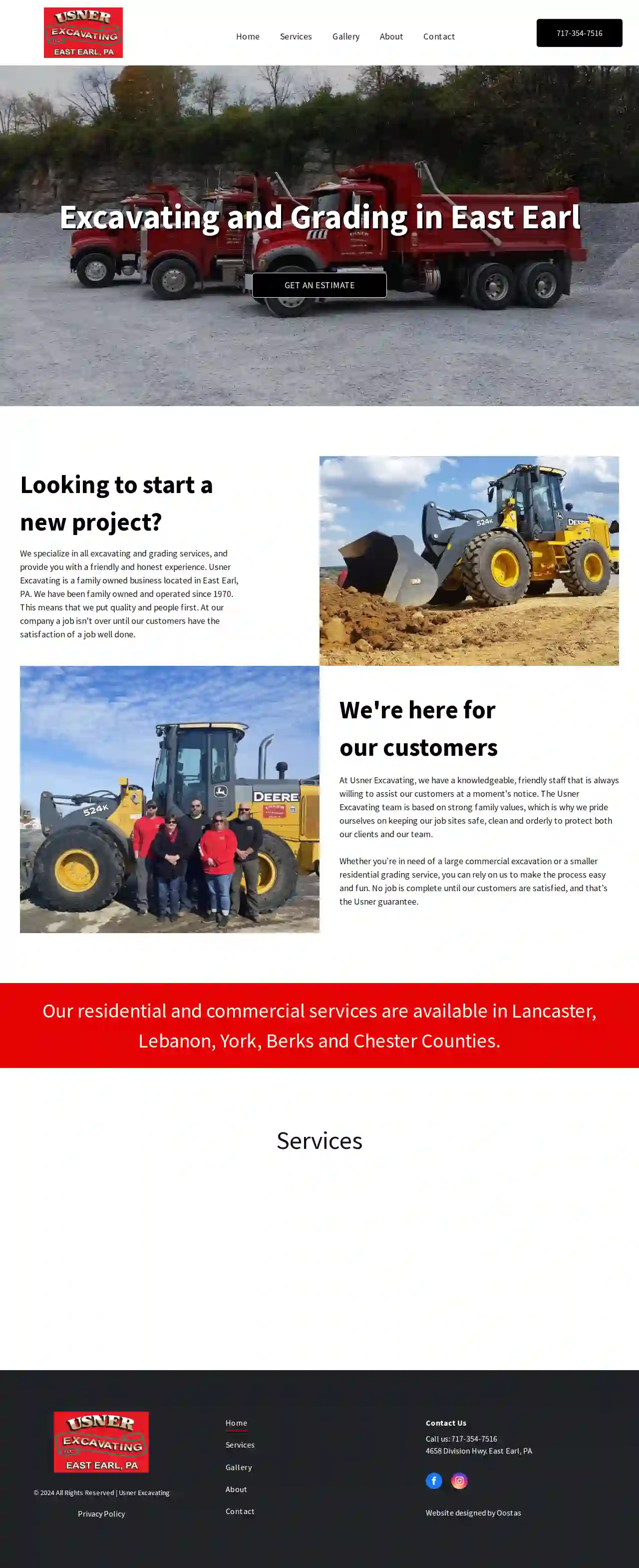Excavation Contractors Colonial Park
Best Excavation Services in Colonial Park
Receive multiple Excavation Companies quotes for your project today! Compare profiles, reviews, accreditations, portfolio, etc... and choose the best service.

Staten Island Masonry- Staten Island Masonry Contractors
518 reviewsYork, USStaten Island Masonry Serving Staten Island and surrounding areas Staten Island Masonry and Concrete is the premier choice for masonry and concrete services in Staten Island. Our team of experienced masonry contractors specialize in a variety of services, including brick laying, block laying, and concrete work. We have been providing superior quality masonry and concrete services to Staten Island and the surrounding areas for over 20 years. We are committed to providing outstanding customer service and craftsmanship on every project. Our team is dedicated to providing the highest quality standard of work and strive to exceed our customers’ expectations. We take the time to understand your project and provide a tailored solution that meets your needs.
- Services
- Why Us?
- Testimonials
- Gallery
Get Quote
Stag Excavation Construction & Supply
52 reviewsHamlin, USStag Excavation & Stone Yard Stag Excavation & Stone Yard is a family-owned and operated business serving the Hamlin, PA area. We offer a wide range of services, from excavating and demolition to hardscaping and custom home construction. We are committed to providing our clients with high-quality workmanship and exceptional customer service. Our team of experienced professionals is dedicated to exceeding your expectations and delivering projects on time and within budget. We are proud to be a trusted name in the community and look forward to serving your needs. We are located just outside of Hamlin Corners in Hamlin PA. We offer free estimates on all of our services. Contact us today to schedule a consultation.
- Services
- Why Us?
- Testimonials
- Gallery
Get Quote
Diggerman Excavating
819 Lake Henry Rd., Lake Ariel, 18436, USLooking for a rock and excavation specialist? You've come to the right place! With extreme attention to detail and a passion for excavating, the Diggerman is the man you need for your project!
- Services
- Why Us?
- Gallery
Get Quote
Kuharchik Construction
4.428 reviews420 Schooley Ave, Exeter, 18643, USWE ARE KUHARCHIK CONSTRUCTION. Providing superior electrical contracting services throughout Pennsylvania since 1973. We’re local, we’re family owned, we’re union! Kuharchik is your first choice in Electrical Contracting. From Highway Signing & Lighting to Foundation Installation, we take pride in every job that we do.
- Services
- Why Us?
- Gallery
Get Quote
Perfect Estimator LLC
510 reviews920 HYLAN BLVD, STATEN ISLAND, NEW YORK, 920 HYLAN BLVD STATEN ISLAND, NEW YORK 10305, Staten Island, 10305, USACHIEVE YOUR BIDDING SUCCESS Experience the Power of High-Value Estimating Services Share Gain access to valuable insights and knowledge, empowering you to make informed decisions and win bids confidently. Automate Utilize cutting-edge technology to automate the estimating process, saving time and ensuring accuracy, so you can focus more on your business development. Win Achieve your goal of winning more bids with high-value, accurate estimates, gaining a competitive edge needed to drive your profit gains and business growth. Reliable Estimating and Takeoff Solutions For over a decade and a half, Perfect Estimator LLC has been a beacon of trust in the construction domain, delivering premium quantity take-off and cost estimation services to contractors across the USA, UK, and Australia. Our proficient team of construction estimators has garnered acclaim for their swift and accurate material estimates, tailored to meet the needs of diverse construction trades. Our array of services encompasses precise estimation for residential, commercial, and industrial ventures, meticulously aligned with the standards set by esteemed bodies like the American Estimators Organization and the American Association of Cost Engineers (AACE). At Perfect Estimator LLC, we prioritize adherence to industry guidelines to ensure the utmost accuracy in our estimates. Backed by seasoned construction managers and adept quantity surveyors, Perfect Estimator LLC excels in delivering comprehensive material takeoffs. Leveraging a suite of industry-standard tools and software such as Planswift, Bluebeam, and Trimble, our team guarantees precise estimates that meet the rigorous demands of our clientele. Proficiency in tools and software is integral to our operations at Perfect Estimator LLC. From Planswift to Xactimate, our expertise extends to FastPIPE, FastDUCT, and more, enabling us to deliver accurate estimates efficiently. Additionally, our utilization of RS Means, Craftsmen, and proprietary databases for zip-code-based pricing underscores our commitment to excellence. This proficiency, coupled with our reputation for credibility and affordability, positions Perfect Estimator LLC as a leading provider of construction estimating services.
- Services
- Why Us?
- Gallery
Get Quote
BN Excavating Inc
4.512 reviews100 Furnace Rd., Marietta, 17547, USPreparing the way for tomorrow…today We are first onsite, transforming the ground, providing solutions, and inspiring loyalty…building community. For over 30 years BN Excavating has been a leader in the industry, providing prompt response and valuable solutions while solving new challenges throughout Lancaster, York, Harrisburg and beyond. BN Excavating is a family-owned and operated business with a commitment to quality, safety, and customer satisfaction. We are dedicated to providing our clients with the highest level of service and expertise. Our team of experienced professionals is committed to delivering projects on time and within budget. We are proud to serve the Lancaster, York, Harrisburg and surrounding areas. We are committed to providing our clients with the highest level of service and expertise. Our team of experienced professionals is committed to delivering projects on time and within budget. We are committed to providing our clients with the highest level of service and expertise. Our team of experienced professionals is committed to delivering projects on time and within budget.
- Services
- Why Us?
- Accreditations
- Our Team
- Gallery
Get Quote
Four Bridges Construction & Renovations
131 Main St, Staten Island, 10307, USAbout Four Bridges Construction & Renovations At Four Bridges, we are residential and commercial contractors serving Staten Island and the Tri-State Area. We bring a unique blend of vision and experience, both as building designers and builders, allowing us to offer valuable insight and advice to help you design your dream home, remodel, or addition. We handle site development, planning, zoning, and navigate any hurdles you might encounter in your building project. We stay abreast of the latest construction trends to ensure your project is built with the highest quality and efficiency. Let our years of experienced designing and building work for you.
- Services
- Why Us?
- Gallery
Get Quote
Earth Tech
York, USAbout Us Earth Tech is a leading provider of geotechnical construction services in the southeastern United States. We specialize in ground improvement, foundation support, and sinkhole remediation. Our team of experienced engineers, project managers, and field technicians is committed to providing our clients with the highest quality services and solutions. Company History Earth Tech was founded in 1991 by Ron Broadrick, a veteran of the geotechnical construction industry with over 40 years of experience. Ron’s vision was to create a company that would provide innovative and reliable solutions to the challenges faced by developers, engineers, and homeowners in Florida and beyond. Since its inception, Earth Tech has grown into one of the largest and most respected geotechnical construction companies in the state, with a reputation for quality, safety, and customer service. Menard Leadership Earth Tech is a proud member of the Menard USA family of companies. Menard USA is a leading provider of geotechnical construction services in North America. With a shared commitment to innovation, quality, and customer service, Earth Tech and Menard USA are working together to provide our clients with the best possible solutions. Why Earth Tech? Earth Tech is the premier choice for geotechnical construction services in the southeastern United States. We offer a wide range of services, including: Ground improvement Foundation support Sinkhole remediation Design and value engineering Project resources We are committed to providing our clients with the highest quality services and solutions. Our team of experienced engineers, project managers, and field technicians is dedicated to exceeding your expectations. Safety & Quality Safety is our top priority. We are committed to providing a safe and healthy work environment for our employees and the public. We have a comprehensive safety program that includes regular training, safety audits, and incident reporting. We are also committed to providing our clients with the highest quality services. We use only the best materials and equipment, and our team of experienced professionals is dedicated to delivering projects on time and within budget. Local Focus and Experience Earth Tech is a locally owned and operated company. We are committed to serving our community and providing our clients with the best possible service. We have a deep understanding of the local soil conditions and regulatory requirements, which allows us to provide our clients with the most effective and cost-efficient solutions. Design and Value Engineering Earth Tech has a team of experienced engineers who can provide design and value engineering services for your project. We can help you to develop the most cost-effective and sustainable solutions for your needs. Project Resources Earth Tech has a wide range of resources available to our clients, including: Experienced engineers Project managers Field technicians Specialty equipment Grout material production We are committed to providing our clients with the resources they need to ensure the success of their projects.
- Services
- Why Us?
- Our Team
- Testimonials
- Gallery
Get Quote
Big Rock Excavations
57 reviews409 NORTH ROAD, STROUDSBURG, PA, USABOUT US Whether you’re developing a new piece of land or undertaking a demolition to make room for a new building, our extensive fleet of excavation equipment allows us to complete your excavation on time and on budget, without having to call more than one sub-contractor. As a modern, innovation-driven company, we work to incorporate the latest techniques and equipment to provide our clients the highest value for their time and money. With a focus on client satisfaction, our company only incorporates an in-house team that is trained with the most modern equipment and digging techniques. WHY WORK WITH US? Our friendly site inspectors will provide a thorough analysis and inspection of your site to help you understand the unique needs of your project. We will always uphold our promise of superior communication and provide upfront, detailed pricing for each and every part of the excavation process. Hundreds of satisfied customers have hired us for concrete cutting, concrete repairs, road repairs, demolition and more. Our clients include some of the largest and most-respected names in construction, many of which have awarded us prime contractor status and master service agreements. TRANSPARENT PRICING With the strength of our expert teams and upgraded equipment, you can outsource your entire excavation process with confidence. We are driven by the business principles of value creation and client satisfaction and tirelessly work to safely carry out all our processes without disrupting any surrounding property. EXPERTISE All our team members have decades-long experience in the excavation industry and have proven capabilities of getting the job done perfectly. By continually learning about the advancements in excavation techniques, we provide the most timely and cost-conscious experience to our clients.
- Services
- Why Us?
- Gallery
Get Quote
Usner Excavating
54 reviews4658 Division Hwy., East Earl, PA, USUsner Excavating: A Family Legacy of Quality and Service Usner Excavating has been a trusted name in the excavating and grading industry since 1970. Founded by Rodney and Wanda Usner, the company has grown into a family-owned and operated business with a strong commitment to quality, customer satisfaction, and community involvement. From humble beginnings with a 1959 Mack B61 dump truck and a 450 John Deere crawler loader, Usner Excavating has expanded its fleet and expertise to handle a wide range of projects, from residential grading to large-scale commercial excavations. The Usner family takes pride in their work and their dedication to providing a safe, clean, and orderly job site for their clients and team. They believe in building strong relationships with their customers and ensuring their complete satisfaction with every project. Today, Usner Excavating continues to uphold the values of its founders, providing reliable and professional excavating and grading services to customers in Lancaster, Lebanon, York, Berks, and Chester Counties.
- Services
- Why Us?
- Our Team
- Testimonials
- Gallery
Get Quote
Over 22,076+ Excavation Contractors registered
Our excavation contractors operate in Colonial Park and surroundings!
ExcavationHQ has curated and vetted Top Excavation Companies in and around Colonial Park. Find a trustworthy pro today.
Frequently Asked Questions About Excavation Contractors
- Excavators: Versatile machines with a bucket, arm, and rotating cab for digging, lifting, and moving earth.
- Backhoes: Similar to excavators but with a digging bucket on the back and a loader bucket on the front, ideal for trenching and smaller excavations.
- Bulldozers: Powerful machines with a large blade for pushing earth, clearing land, and leveling surfaces.
- Skid Steers: Compact and maneuverable loaders with various attachments (buckets, forks) for digging, loading, and grading in tight spaces.
- Trenchers: Specialized machines for digging narrow trenches for utilities.
- Dump Trucks: Vehicles for hauling excavated material to disposal sites.
- New Construction: Laying foundations, basements, or underground utilities for new buildings.
- Home Additions: Creating space for new rooms, basements, or extensions.
- Landscaping: Leveling ground, creating slopes, installing retaining walls, or digging for ponds or pools.
- Drainage Improvement: Installing French drains, drainage ditches, or swales to manage water runoff.
- Utility Installation or Repair: Laying new water, sewer, gas, or electrical lines, or repairing existing ones.
- Demolition: Clearing debris and preparing the site after demolishing a structure.
- Trench Collapses: Unstable trench walls can cave in, posing a severe risk to workers. Proper shoring and sloping are crucial safety measures.
- Utility Damage: Striking underground utilities (gas, water, electric) can cause leaks, explosions, or electrocution. Accurate utility locates and careful digging are essential.
- Falling Objects: Materials or equipment falling into excavations can injure workers. Securing work areas and using appropriate safety gear is vital.
- Equipment Accidents: Operating heavy machinery involves risks of rollovers, collisions, or mechanical failures. Trained operators and proper equipment maintenance are critical.
- Environmental Hazards: Excavated soil might contain hazardous materials (asbestos, lead). Proper testing and disposal procedures are necessary.
What equipment is used for excavation?
How do I know if I need excavation for my project?
What is the difference between cut and fill excavation?
Cut: Involves excavating soil from an area where the existing grade is higher than the desired grade.
Fill: Refers to using the excavated soil ('cut' material) to raise the grade in an area where the existing grade is lower than desired.
This method minimizes the need to import or export soil, reducing costs and environmental impact. It's commonly used for site preparation, road construction, and landscaping.
What are the risks associated with excavation?
What equipment is used for excavation?
- Excavators: Versatile machines with a bucket, arm, and rotating cab for digging, lifting, and moving earth.
- Backhoes: Similar to excavators but with a digging bucket on the back and a loader bucket on the front, ideal for trenching and smaller excavations.
- Bulldozers: Powerful machines with a large blade for pushing earth, clearing land, and leveling surfaces.
- Skid Steers: Compact and maneuverable loaders with various attachments (buckets, forks) for digging, loading, and grading in tight spaces.
- Trenchers: Specialized machines for digging narrow trenches for utilities.
- Dump Trucks: Vehicles for hauling excavated material to disposal sites.
How do I know if I need excavation for my project?
- New Construction: Laying foundations, basements, or underground utilities for new buildings.
- Home Additions: Creating space for new rooms, basements, or extensions.
- Landscaping: Leveling ground, creating slopes, installing retaining walls, or digging for ponds or pools.
- Drainage Improvement: Installing French drains, drainage ditches, or swales to manage water runoff.
- Utility Installation or Repair: Laying new water, sewer, gas, or electrical lines, or repairing existing ones.
- Demolition: Clearing debris and preparing the site after demolishing a structure.
What is the difference between cut and fill excavation?
Cut: Involves excavating soil from an area where the existing grade is higher than the desired grade.
Fill: Refers to using the excavated soil ('cut' material) to raise the grade in an area where the existing grade is lower than desired.
This method minimizes the need to import or export soil, reducing costs and environmental impact. It's commonly used for site preparation, road construction, and landscaping.
What are the risks associated with excavation?
- Trench Collapses: Unstable trench walls can cave in, posing a severe risk to workers. Proper shoring and sloping are crucial safety measures.
- Utility Damage: Striking underground utilities (gas, water, electric) can cause leaks, explosions, or electrocution. Accurate utility locates and careful digging are essential.
- Falling Objects: Materials or equipment falling into excavations can injure workers. Securing work areas and using appropriate safety gear is vital.
- Equipment Accidents: Operating heavy machinery involves risks of rollovers, collisions, or mechanical failures. Trained operators and proper equipment maintenance are critical.
- Environmental Hazards: Excavated soil might contain hazardous materials (asbestos, lead). Proper testing and disposal procedures are necessary.